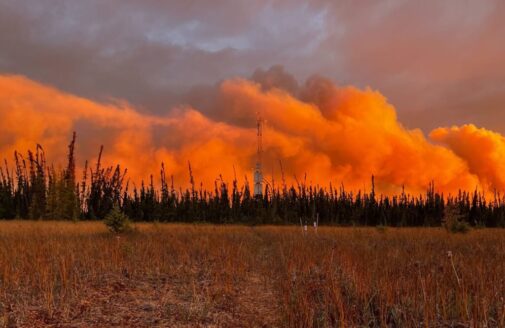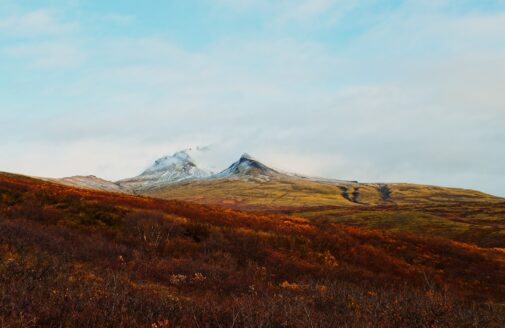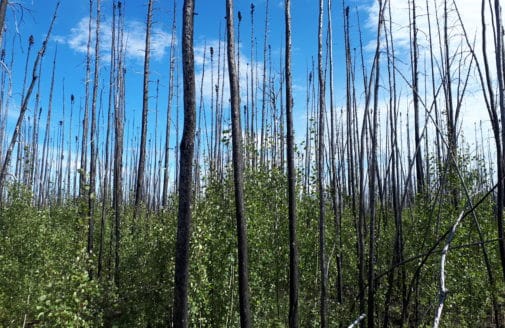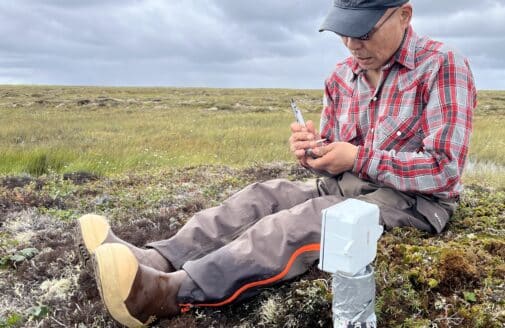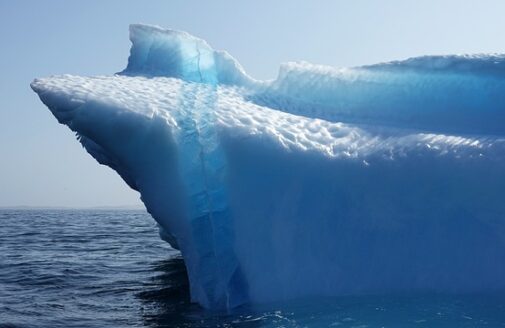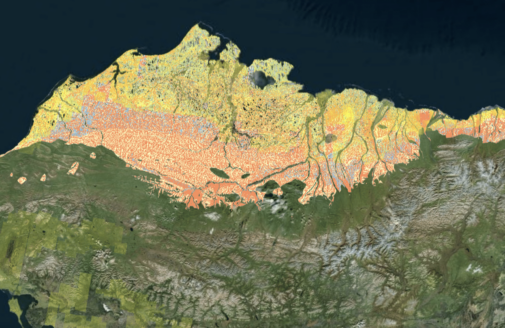Fire suppression deployed in Yukon Flats National Wildlife Refuge to protect carbon
Fighting fire in remote boreal forests could be a cost effective way of combating climate change
Aerial view of Yukon Flats National Wildlife Refuge.
photo by Steve Hillebrand
Read a summary of the fire management strategy.
Located in Eastern Alaska, the Yukon Flats National Wildlife Refuge is larger than many U.S. states. It’s a roadless landscape of rocky mountain outcroppings, flat meadows, treeless tundra, and dense spruce forests, bisected by the Yukon River and dotted with thousands of lakes and wetlands. Several Alaska Native communities call the refuge home and subsist off of its natural resources. This diverse, expansive wilderness is well adapted to fire, and it’s not uncommon to see pink fireweed blooms or young grass and seedlings sprouting from burn scars.
But the relationship between fire and land here—as in many places—has been changing as the climate warms. Yukon Flats sits atop ancient, ice-rich ground, called Yedoma permafrost, formed during the last ice age. Thawing Yedoma is a significant source of carbon dioxide and methane emissions to the atmosphere. Fire, made more intense and frequent by climate change, threatens to accelerate that thaw. In an effort to preserve carbon stores, the U.S. Fish and Wildlife Service recently dedicated 1.6 million acres of the Yukon Flats refuge to piloting a new firefighting regime, one designed to protect carbon, in addition to human lives and property.
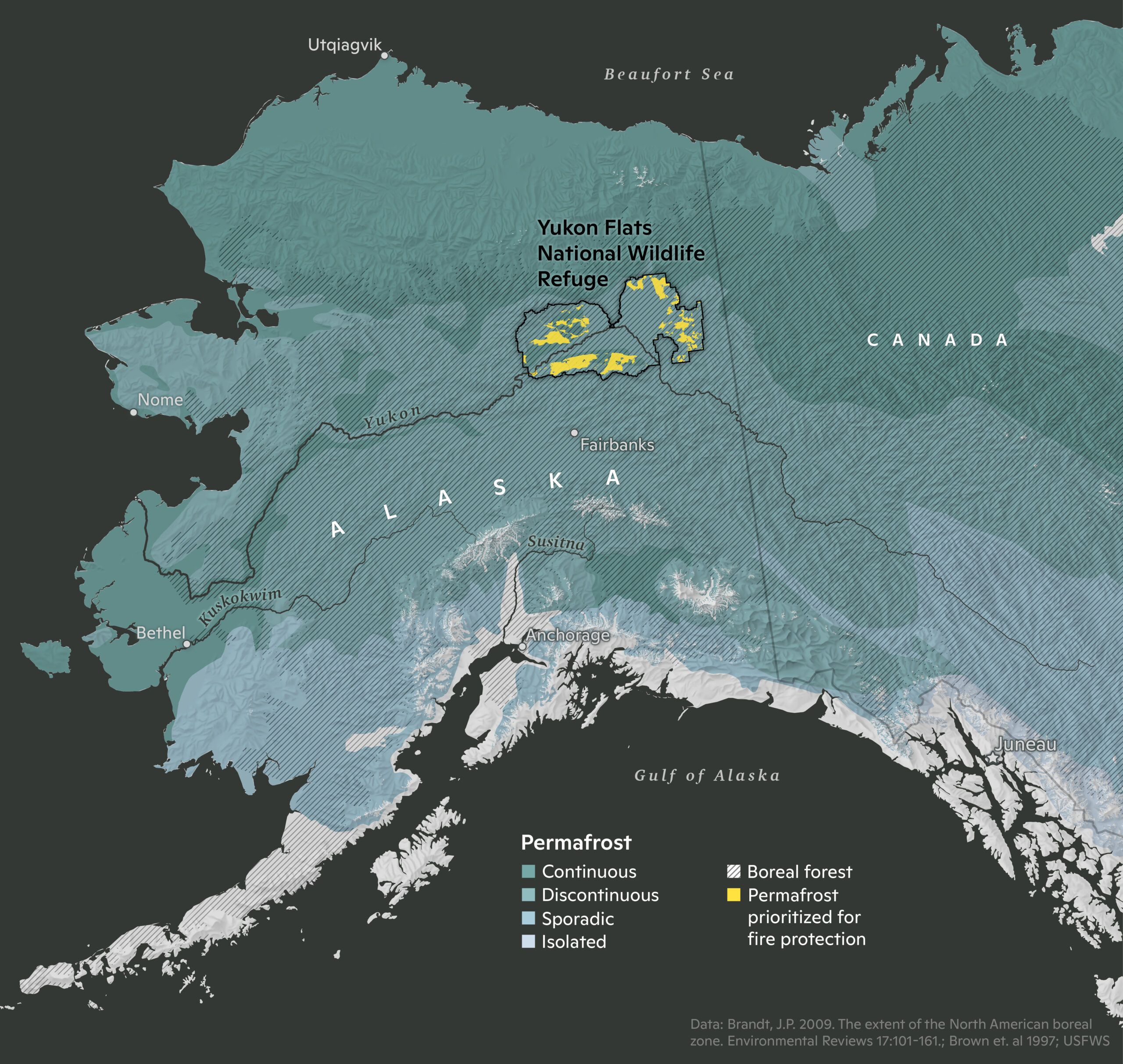
map by Christina Shintani
Science builds the case for policy change
This decision was, in part, influenced by research led by Dr. Carly Phillips, during her time as a research scientist at the Union of Concerned Scientists, alongside Woodwell Climate Senior Science Policy Advisor, Dr. Peter Frumhoff, and Associate Scientist, Dr. Brendan Rogers. In a 2022 paper in Science Advances, the group quantified the threat boreal forest fires pose to climate goals. Wildfires in boreal North America alone could, by mid-century, use up 3% of remaining global carbon dioxide emissions associated with keeping temperatures below the Paris Agreement’s 1.5°C limit. This is a conservative estimate—the authors suggest the true numbers could be even larger as the accelerating effect of fires on permafrost thaw, and the release of other greenhouse gasses, were not included in the analysis.
The study also examined the cost-effectiveness of combatting those fires as a potential climate solution. Molly Elder, an economics and public policy Ph.D. candidate at Tufts, performed an analysis of data from across Alaska’s fire management zones and found that actively suppressing boreal fires could cost less than 13 dollars per ton of carbon dioxide emissions avoided—putting it on par with other carbon mitigation solutions like onshore wind or utility-scale solar.
“The work we did in this project proved and quantified what the management community already knew, which is that management is effective at reducing burned area when fires are actively suppressed,” says Elder.
Combating boreal fires could provide much needed mitigation, and at a low cost, but there are some logistical obstacles between the hypothetical model and actual implementation. Typically, in Alaska, boreal forest fires are left to burn unless they present a risk to human life or property. This is partly because these forests are fire-adapted, but also partly due to the sheer vastness of boreal wilderness. With limited resources, it is not always practical or possible to track down and put out a fire, especially in a place without roads like Yukon Flats. Firefighters are already stretched thin with lengthening and increasingly high-intensity fire seasons.
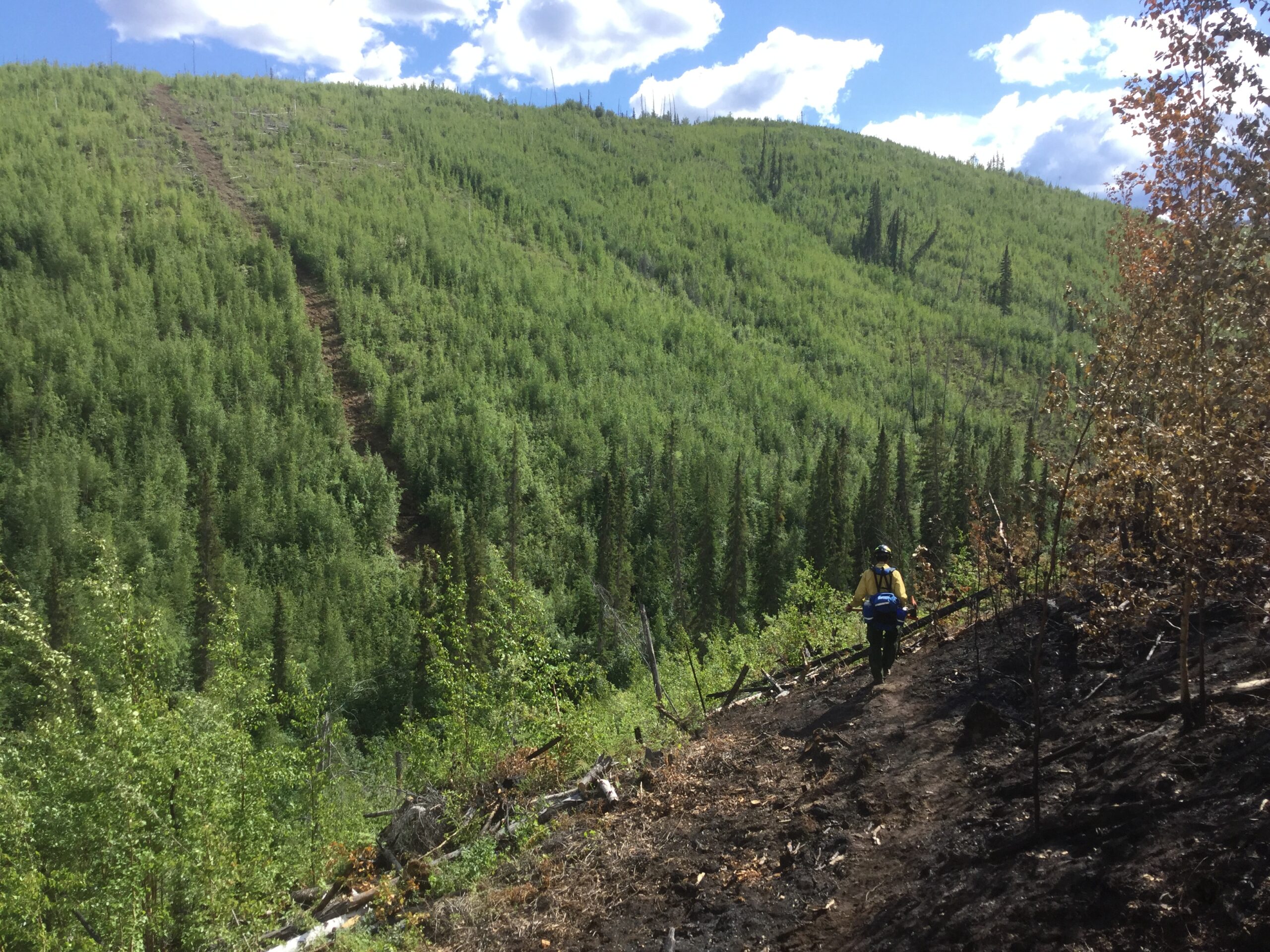
State of Alaska firefigher, Andrew Allaby, walks a fire break at Yukon Flats National Wildlife Refuge in 2020 on the Isom Creek Fire.
photo by Dale Woitas
So the research group worked with the fire management community in Alaska, facilitated by the Alaska Fire Science Consortium, to better understand the needs of firefighters and demonstrate the co-benefits of fire suppression in addition to preserving carbon.
“Many of the fire managers expressed how stretched their resources already were and resistance to the idea that yet another mandate would be added to their plate,” says Phillips. “However, after discussing the implications of our research, and the ambition that additional funding would come with any mandate, we got more buy-in.”
Fire suppression: It’s not a dirty word
The other concern managers raised was whether fire suppression would ultimately be successful in achieving their goals. Historically, fire suppression efforts in the US have been counterproductive to protecting forests.
In the late 1800s, lack of understanding of the ways Indigenous communities in Western states have used fire to maintain healthy forests resulted in decades of near-total suppression of fire in the region. In many western US forests, (adapted to what Rogers calls “high-frequency, low-intensity” fire) suppression allowed highly flammable, dry vegetation—which would normally be periodically burned away—to build up. When fires did spark, they were then capable of growing to a size and intensity that could damage, rather than activate, the forest.
But in boreal Alaska and Canada, it’s just the opposite. The spruce-dominated forests are adapted to high-intensity fires that only return every hundred or so years. As climate change speeds up the return of fires with hotter and drier conditions, boreal forests have begun to suffer major losses.
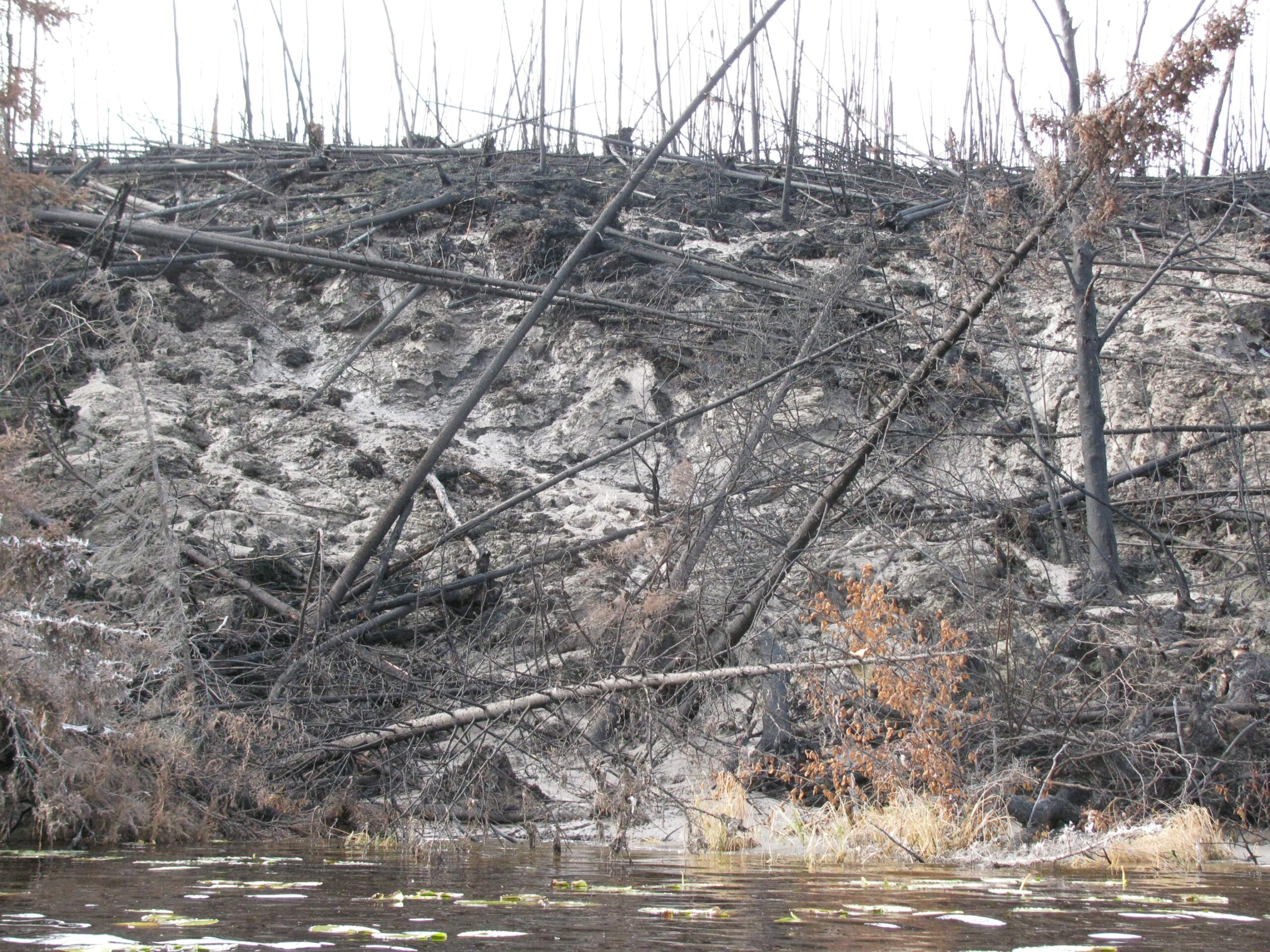
Thawed Yedoma permafrost and burnt trees after a fire in Yukon Flats.
photo by Torre Jorgenson
“The frequency of boreal fires, ultimately, is increasing. In many places we’re seeing more reburning and larger burned areas,” says Rogers. “Climate change and human actions are shifting that fire regime out of its historical range into this new realm. So the whole idea of fire suppression in the boreal is to keep fires closer to historical levels, to which the systems and fauna are adapted. Suppression can help delay permafrost degradation, limiting carbon emissions and buying us time to reach our climate targets.”
Past missteps with fire suppression have made fire managers cautious, though. Lisa Saperstein, Regional Fire Ecologist with U.S. Fish and Wildlife, notes that, with limited resources, priorities in intense fire seasons will have to shift to protecting human settlements over carbon and permafrost. But, given the co-benefits of keeping fire activity to historic levels—and the urgency of reigning in emissions in any way we can—managers in Yukon Flats were willing to try.
“This type of shift in values is always difficult, especially when the outcome is uncertain. Support from leaders of fire management organizations, in addition to land managers, has been a key factor in this effort moving forward,” says Saperstein.
Aerial view of the Chandalar River Fire, 2017.
photo by U.S. Fish and Wildlife Service
If a fire starts in the woods, how do you fight it?
This change in tactics won’t mean that every fire that ignites will be put out—both impractical and unhelpful from an ecological perspective—but it will mean more aggressively targeting fires when they arise. Since the 1980s, when fire was detected in Yukon Flats, it would be monitored by the Alaska Fire Service, but not suppressed, except when presenting a threat to human communities.
“This pilot project is a new twist to a long-standing partnership between the U.S. Fish and Wildlife Service and Alaska Fire Service. For select areas of the Refuge, now if a fire start is detected, we ask the Alaska Fire Service to only send a crew if they are confident in 100% containment within three days,” says Yukon Flats Refuge Manager, Jimmy Fox.
The suppression teams will target fires that they judge as “quick fixes,” curbing the potential for them to grow into large, stand-replacing sized blazes. If a fire becomes too big to fight quickly, the teams revert to the old tactic of simply monitoring.
“If a crew is deployed, we ask that they cease suppression and return to base after three days, regardless of containment status,” says Fox. “This request is grounded in concern for the Alaska Fire Service having resources available if communities become threatened from other fires.”
This is the proof of concept. This is the opportunity to really see in a rigorous way whether we can apply this solution at a meaningful scale and gain meaningful carbon benefits.Dr. Peter Frumhoff
Fox says refuge management and Alaska Fire Service members will stay flexible as the pilot project unfolds so they can respond to changing conditions.
“In conservation, we tend to focus on the technical aspects of a challenge and avoid the difficulties that come with asking ourselves to adapt,” says Fox. “This pilot project is both adaptive and technical. It has required me to stay curious and listen. It has required me to learn new information, and share it in a way that is comprehensible. It’s required being comfortable with uncertainty, and yet standing in purpose. It has been a learning journey so far, and will continue to be.”
Putting models to the test
On the research side, the team at Woodwell Climate hopes this new strategy will present an opportunity to study the practical implementation of fire suppression as a climate solution.
“This is the proof of concept,” says Frumhoff. “This is the opportunity to really see in a rigorous way whether we can apply this solution at a meaningful scale and gain meaningful carbon benefits with relatively modest cost. And it’s directly traceable to the conversations that the research team had with fire managers.”
The 1.6 million acres slated for fire suppression are small compared to the 8.6 million that comprise the entire refuge, or the 5.6 billion acres of permafrost in the northern hemisphere, but it’s a very important start. Research and analysis of the effectiveness of this solution could aid its expansion to other regions of the Arctic.
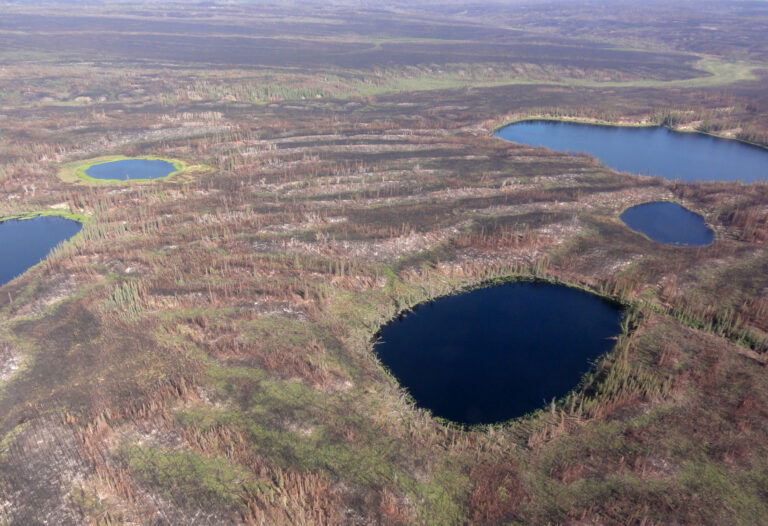
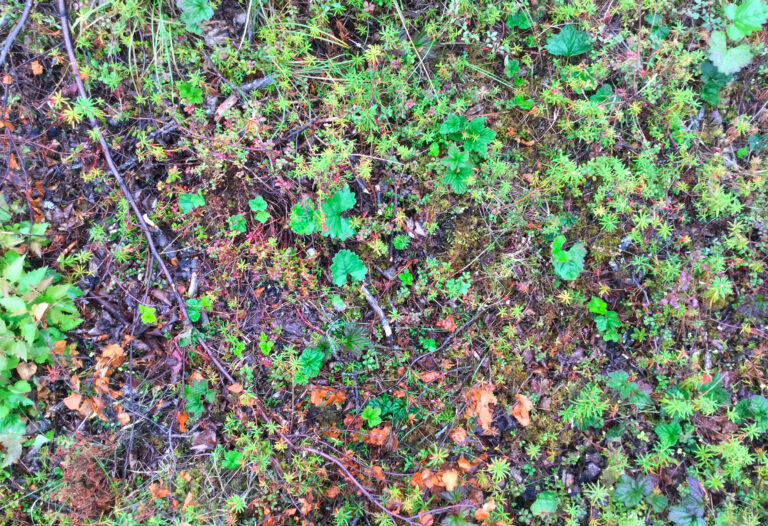
(left) Aerial view of recent burn scar and (right) new plant growth in a recovering area of the refuge.
photos by Torre Jorgenson and Dale Woitas
“It’s a big moment, because, while it’s obviously a relatively small area compared to all of Alaska, 1.6 million acres is still a lot of land,” says Rogers. “We’re hoping that it’s a jumping off point and can translate to other refuges and other agencies with the addition of proper funding and staffing.”
And each summer, the case for protecting permafrost and boreal carbon, while working to dramatically reduce emissions from fossil fuels, continues to grow.
“Every year that goes by, as fires intensify and climate change gets worse, this message might resonate just a little more, ” says Rogers. “Because it’s a problem that’s not going away if we do nothing about it. And we can do something about it.”




